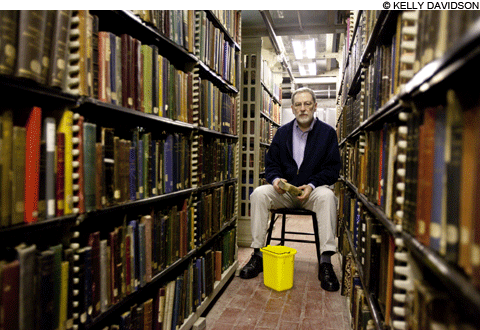
BE PREPARED James Reid-Cunningham’s disaster plan helped save the Athenaeum. |
On January 24, around three in the afternoon, a sprinkler pipe broke in the ceiling of the first floor of the Boston Athenaeum.
An alarm sounded. Water rained from the ceiling in a great gush, splashing early American portraits, antique wooden furniture, oriental rugs — and patrons, who were ordered out of the building and onto the freezing street.
Within an hour, a good part of the first floor was covered in four inches of standing water. The water cascaded down the stairwell and the elevator shaft, seeping into the basement and the sub-basement, which house 50,000 books in a collection dating back to the early 19th century. Though many of the library's most precious books are stored on its upper floors, the basement contains a number of irreplaceable old volumes. Recently, a librarian found a first edition of On the Origin of Species still in circulation.
James Reid-Cunningham, the Athenaeum's chief conservator and disaster man, remained in the building with nine other employees who knew exactly what to do. As water rained from the ceiling and the fire department made sure the library wasn't burning, some staffers trolled the building in hopes of determining the source of the water leak. Others covered paintings, busts, and shelves with plastic sheeting. Still others tried to dam the water with cloth snakes.
"People get really agitated when there's water booming out of the ceiling, especially if you've dedicated your life to the care of this collection — it's easy to get panicky," says Reid-Cunningham. "Fortunately, I've done this kind of thing before."
On the back page of the Athenaeum's disaster plan is the number for a man named James Gilbert. Right after Reid-Cunningham got off the phone with the fire department, he punched in Gilbert's number. But he didn't have to look it up — he has Gilbert on speed dial.
A RIVER RAN THROUGH IT
James Gilbert is a document man. When a library suffers a cataclysm, his job is to rush in and save imperiled cultural materials.
Gilbert's work has taken him to New Orleans after Hurricane Katrina and to Texas after Hurricane Ike to salvage what was left of their libraries. The worst disaster he's ever seen was in Iowa, when the Cedar Rapids Public Library was drenched during that city's catastrophic 2008 flood. The river went through the building, leaving behind eight feet of water and around 200,000 ruined books. Gilbert stayed for nearly three months.
"That building was completely gutted," he says. "We threw out most of the general-collection books because [saving them] would have been cost-prohibitive. If it's a Stephen King book, you can buy a new one, you know?"
Not so with the Athenaeum. The newest of its 900 damaged volumes date from the early 20th century, and some are more than 200 years old.
Broken pipes, overflowing toilets, leaky roofs, and flooding basements — phenomena known to those in the preservation field as "water events" — are the most common cause of book damage. Gilbert deals with all of them. No matter the magnitude of the damage or the value of the collection, Gilbert's team handles each water event in much the same way. First, they suck up all the water with a machine that Gilbert says is similar to a carpet cleaner. Then they gather all the wet books.